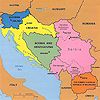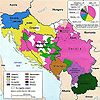

In the Republic of Bosnia-Herzegovina, conflict between the three main ethnic groups, the Serbs, Croats, and Muslims, resulted in genocide committed by the Serbs against the Muslims in Bosnia.
Bosnia is one of several small countries that emerged from the break-up of Yugoslavia, a multicultural country created after World War I by the victorious Western Allies. Yugoslavia was composed of ethnic and religious groups that had been historical rivals, even bitter enemies, including the Serbs (Orthodox Christians), Croats (Catholics) and ethnic Albanians (Muslims).
During World War II, Yugoslavia was invaded by Nazi Germany and was partitioned. A fierce resistance movement sprang up led by Josip Tito. Following Germany's defeat, Tito reunified Yugoslavia under the slogan "Brotherhood and Unity," merging together Slovenia, Croatia, Bosnia, Serbia, Montenegro, Macedonia, along with two self-governing provinces, Kosovo and Vojvodina.
Tito, a Communist, was a strong leader who maintained ties with the Soviet Union and the United States during the Cold War, playing one superpower against the other while obtaining financial assistance and other aid from both. After his death in 1980 and without his strong leadership, Yugoslavia quickly plunged into political and economic chaos.
A new leader arose by the late 1980s, a Serbian named Slobodan Milosevic, a former Communist who had turned to nationalism and religious hatred to gain power. He began by inflaming long-standing tensions between Serbs and Muslims in the independent provence of Kosovo. Orthodox Christian Serbs in Kosovo were in the minority and claimed they were being mistreated by the Albanian Muslim majority. Serbian-backed political unrest in Kosovo eventually led to its loss of independence and domination by Milosevic.
In June 1991, Slovenia and Croatia both declared their independence from Yugoslavia soon resulting in civil war. The national army of Yugoslavia, now made up of Serbs controlled by Milosevic, stormed into Slovenia but failed to subdue the separatists there and withdrew after only ten days of fighting.
Milosevic quickly lost interest in Slovenia, a country with almost no Serbs. Instead, he turned his attention to Croatia, a Catholic country where Orthodox Serbs made up 12 percent of the population.
During World War II, Croatia had been a pro-Nazi state led by Ante Pavelic and his fascist Ustasha Party. Serbs living in Croatia as well as Jews had been the targets of widespread Ustasha massacres. In the concentration camp at Jasenovac, they had been slaughtered by the tens of thousands.
In 1991, the new Croat government, led by Franjo Tudjman, seemed to be reviving fascism, even using the old Ustasha flag, and also enacted discriminatory laws targeting Orthodox Serbs.
Aided by Serbian guerrillas in Croatia, Milosevic's forces invaded in July 1991 to 'protect' the Serbian minority. In the city of Vukovar, they bombarded the outgunned Croats for 86 consecutive days and reduced it to rubble. After Vukovar fell, the Serbs began the first mass executions of the conflict, killing hundreds of Croat men and burying them in mass graves.
The response of the international community was limited. The U.S. under President George Bush chose not to get involved militarily, but instead recognized the independence of both Slovenia and Croatia. An arms embargo was imposed for all of the former Yugoslavia by the United Nations. However, the Serbs under Milosevic were already the best armed force and thus maintained a big military advantage.
By the end of 1991, a U.S.-sponsored cease-fire agreement was brokered between the Serbs and Croats fighting in Croatia.
In April 1992, the U.S. and European Community chose to recognize the independence of Bosnia, a mostly Muslim country where the Serb minority made up 32 percent of the population. Milosevic responded to Bosnia's declaration of independence by attacking Sarajevo, its capital city, best known for hosting the 1984 Winter Olympics. Sarajevo soon became known as the city where Serb snipers continually shot down helpless civilians in the streets, including eventually over 3,500 children.
Bosnian Muslims were hopelessly outgunned. As the Serbs gained ground, they began to systematically roundup local Muslims in scenes eerily similar to those that had occurred under the Nazis during World War II, including mass shootings, forced repopulation of entire towns, and confinement in make-shift concentration camps for men and boys. The Serbs also terrorized Muslim families into fleeing their villages by using rape as a weapon against women and girls.
The actions of the Serbs were labeled as 'ethnic cleansing,' a name which quickly took hold among the international media.
Despite media reports of the secret camps, the mass killings, as well as the destruction of Muslim mosques and historic architecture in Bosnia, the world community remained mostly indifferent. The U.N. responded by imposing economic sanctions on Serbia and also deployed its troops to protect the distribution of food and medicine to dispossessed Muslims. But the U.N. strictly prohibited its troops from interfering militarily against the Serbs. Thus they remained steadfastly neutral no matter how bad the situation became.
Throughout 1993, confident that the U.N., United States and the European Community would not take militarily action, Serbs in Bosnia freely committed genocide against Muslims. Bosnian Serbs operated under the local leadership of Radovan Karadzic, president of the illegitimate Bosnian Serb Republic. Karadzic had once told a group of journalists, "Serbs and Muslims are like cats and dogs. They cannot live together in peace. It is impossible."
When Karadzic was confronted by reporters about ongoing atrocities, he bluntly denied involvement of his soldiers or special police units.
On February 6, 1994, the world's attention turned completely to Bosnia as a marketplace in Sarajevo was struck by a Serb mortar shell killing 68 persons and wounding nearly 200. Sights and sounds of the bloody carnage were broadcast globally by the international news media and soon resulted in calls for military intervention against the Serbs.
The U.S. under its new President, Bill Clinton, who had promised during his election campaign in 1992 to stop the ethnic cleansing in Bosnia, now issued an ultimatum through the North Atlantic Treaty Organization (NATO) demanding that the Serbs withdraw their artillery from Sarajevo. The Serbs quickly complied and a NATO-imposed cease-fire in Sarajevo was declared.
The U.S. then launched diplomatic efforts aimed at unifying Bosnian Muslims and the Croats against the Serbs. However, this new Muslim-Croat alliance failed to stop the Serbs from attacking Muslim towns in Bosnia which had been declared Safe Havens by the U.N. A total of six Muslim towns had been established as Safe Havens in May 1993 under the supervision of U.N. peacekeepers.
Bosnian Serbs not only attacked the Safe Havens but also attacked the U.N. peacekeepers as well. NATO forces responded by launching limited air strikes against Serb ground positions. The Serbs retaliated by taking hundreds of U.N. peacekeepers as hostages and turning them into human shields, chained to military targets such as ammo supply dumps.
At this point, some of the worst genocidal activities of the four-year-old conflict occurred. In Srebrenica, a Safe Haven, U.N. peacekeepers stood by helplessly as the Serbs under the command of General Ratko Mladic systematically selected and then slaughtered nearly 8,000 men and boys between the ages of twelve and sixty - the worst mass murder in Europe since World War II. In addition, the Serbs continued to engage in mass rapes of Muslim females.
On August 30, 1995, effective military intervention finally began as the U.S. led a massive NATO bombing campaign in response to the killings at Srebrenica, targeting Serbian artillery positions throughout Bosnia. The bombardment continued into October. Serb forces also lost ground to Bosnian Muslims who had received arms shipments from the Islamic world. As a result, half of Bosnia was eventually retaken by Muslim-Croat troops.
Faced with the heavy NATO bombardment and a string of ground losses to the Muslim-Croat alliance, Serb leader Milosevic was now ready to talk peace. On November 1, 1995, leaders of the warring factions including Milosevic and Tudjman traveled to the U.S. for peace talks at Wright-Patterson Air Force base in Ohio.
After three weeks of negotiations, a peace accord was declared. Terms of the agreement included partitioning Bosnia into two main portions known as the Bosnian Serb Republic and the Muslim-Croat Federation. The agreement also called for democratic elections and stipulated that war criminals would be handed over for prosecution. 60,000 NATO soldiers were deployed to preserve the cease-fire.
By now, over 200,000 Muslim civilians had been systematically murdered. More than 20,000 were missing and feared dead, while 2,000,000 had become refugees. It was, according to U.S. Assistant Secretary of State Richard Holbrooke, "the greatest failure of the West since the 1930s."
Copyright © 1999 The History Place™ All Rights Reserved
![]()
- NEXT SECTION - Rwanda: 1994
- Genocide Index Page
- The History Place Main Page
- U.N. International Criminal Tribunal for the former Yugoslavia
Terms of use: Private home/school non-commercial, non-Internet re-usage only is allowed of any text, graphics, photos, audio clips, other electronic files or materials from The History Place.

